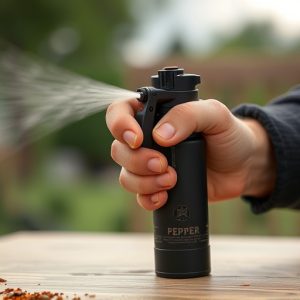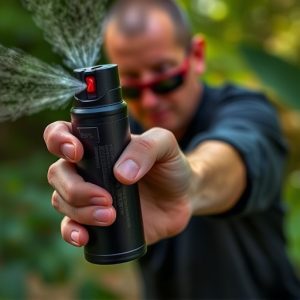Capsaicin Crowd Control: Efficacy, Safety, & Removal of Pepper Spray
Capsaicin, a heat-inducing compound in chili peppers, is used in crowd control pepper sprays for its…….
Capsaicin, a heat-inducing compound in chili peppers, is used in crowd control pepper sprays for its ability to cause intense irritation and temporary disability. These non-lethal sprays can penetrate clothing and skin, making them effective against protected suspects. To remove capsaicin residue from clothing after exposure, rinse affected areas with water, soak garments in detergent and warm water, then gently agitate and wash as usual. Safety precautions include wearing proper gear, rinsing for at least 15 minutes upon exposure, and training users before deployment. Legal frameworks vary globally, with strict regulations to protect officers and civilians from misuse of capsaicin-based crowd control sprays. Promptly removing pepper spray from clothing is crucial to minimize legal risks and health complications.
“Discover the power of capsaicin-based inflammatory crowd control sprays, a non-lethal solution transforming public safety. This article delves into the science behind this potent compound, exploring its effectiveness in managing crowds and its impact on various surfaces. We’ll guide you through practical tips on removing pepper spray from clothing, addressing critical safety considerations, and discussing legal implications. Learn about real-world applications and stay informed about this game-changing tool for crowd control.”
- Understanding Capsaicin: The Active Ingredient
- How Capsaicin-Based Sprays Work for Crowd Control
- Effective Removal Techniques: Getting Pepper Spray Off Clothing
- Safety Considerations and Potential Side Effects
- Legal Implications and Use Cases for Crowd Control Sprays
Understanding Capsaicin: The Active Ingredient
Capsaicin, the active ingredient in pepper spray, is a natural compound derived from chili peppers. It’s what gives spices their heat and pungent sensation. In crowd control applications, capsaicin is used to create an intense irritation and temporary incapacitation, allowing for safe dispersal of individuals. When deployed as a spray, it rapidly binds to pain receptors in the eyes, nose, and respiratory system, leading to tearing, sneezing, coughing, and difficulty breathing.
Understanding how capsaicin interacts with the body is crucial when considering its use for crowd control. It’s important to note that removing pepper spray from clothing isn’t straightforward; it requires thorough washing with soap and water. In public spaces, quick response teams must be trained to manage its effects while ensuring the safety of both the individuals targeted and nearby bystanders.
How Capsaicin-Based Sprays Work for Crowd Control
Capsaicin-based crowd control sprays have gained attention as innovative non-lethal tools for law enforcement agencies worldwide. The active ingredient, capsaicin, is derived from chili peppers and is responsible for the spicy sensation it creates. When deployed in a spray form, it disrupts normal human functioning by targeting the body’s nerve endings, specifically those associated with pain and temperature perception. This disruption causes an immediate reaction, including teary eyes, difficulty breathing, and temporary incapacitation, effectively diffusing potentially violent situations.
Unlike traditional pepper spray, which primarily affects the respiratory system, capsaicin sprays have a broader impact due to their ability to penetrate clothing and skin. This feature makes them particularly useful for crowd control scenarios where suspects might be wearing protective gear or clothing that could make traditional pepper spray less effective. The non-lethal nature of these sprays ensures that bystanders and law enforcement officers remain safe while effectively managing and controlling crowds in various settings, from public demonstrations to high-risk security events. Additionally, the removal process is straightforward; capsaicin residue can be easily washed off clothing, making it easier for individuals to return to their regular activities after exposure.
Effective Removal Techniques: Getting Pepper Spray Off Clothing
When it comes to effective removal techniques for pepper spray on clothing, prompt action is key. The first step is to quickly remove any contaminated garments, ensuring that you do so in a well-ventilated area to minimize exposure. Rinse the affected areas with plenty of water, holding the fabric away from your face and body to prevent further contact.
For stubborn stains, soak the clothing in a mixture of mild detergent and warm water for about 15-20 minutes. Gently agitate the fabric, then wash as usual following the care label instructions. Avoid using harsh chemicals or bleach, as these can set the pepper spray stain and make it harder to remove. Always test cleaning solutions on a small hidden area first to ensure they don’t damage the fabric or cause discoloration.
Safety Considerations and Potential Side Effects
When considering a capsaicin-based inflammatory crowd control spray, it’s paramount to weigh its effectiveness against potential safety considerations and side effects. Capsaicin, the active ingredient derived from chili peppers, can cause severe discomfort, including skin irritation, respiratory distress, and even temporary blindness if splashed in the eyes. These effects can last for several hours, necessitating proper removal of pepper spray from clothing and skin as soon as possible.
Proper safety gear, such as gloves and protective eyewear, should be worn during deployment to minimize direct contact with the spray. In case of accidental exposure, immediate rinsing with water for at least 15 minutes is recommended, especially for eyes and sensitive areas. While capsaicin sprays are designed for crowd control, they should only be used as a last resort, and users must receive adequate training to ensure responsible and safe handling.
Legal Implications and Use Cases for Crowd Control Sprays
The legal implications of using crowd control sprays, particularly those based on capsaicin, vary significantly across jurisdictions. In many countries, these substances are classified as less-lethal or non-lethal tools for law enforcement, allowing their use in specific circumstances to control rioting or aggressive crowds. However, strict regulations govern their deployment to ensure the safety of both officers and civilians, with guidelines on training, equipment maintenance, and de-escalation techniques. Non-compliance can result in legal repercussions, including charges of assault or battery, especially if pepper spray is not effectively removed from clothing or skin after use.
Use cases for capsaicin-based crowd control sprays include public demonstrations, sporting events where crowds may become unruly, and situations requiring rapid dispersal of a crowd. Their ability to cause temporary yet effective discomfort can help de-escalate tense scenarios. Proper application techniques, such as aiming for the eyes and face (while adhering to safety protocols), can ensure the spray’s potency is utilized without causing unnecessary harm or long-term damage. Additionally, post-application measures, including providing access to removal stations or supplies to immediately wash affected areas, are crucial not only to minimize legal risks but also to help individuals affected by the spray resume their activities promptly while mitigating health complications associated with pepper spray removal from clothing.
Capsaicin-based inflammatory crowd control sprays offer a non-lethal alternative for law enforcement and security personnel, effectively managing crowds through their intense heat and irritation effects. However, proper safety measures and knowledge of removal techniques are crucial to mitigate potential side effects and ensure responsible use. Understanding the legal implications and effective methods to remove pepper spray from clothing, such as using neutralizing solutions or specific detergents, is essential for both users and those potentially affected. By adhering to guidelines and continuous research, these crowd control sprays can be utilized responsibly, enhancing public safety without causing lasting harm.


